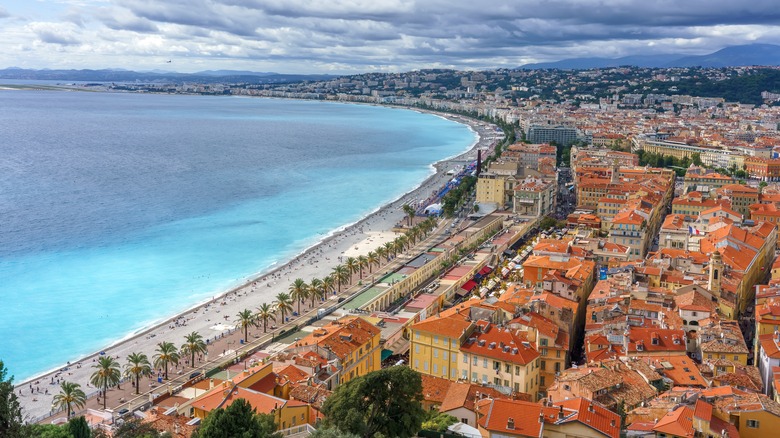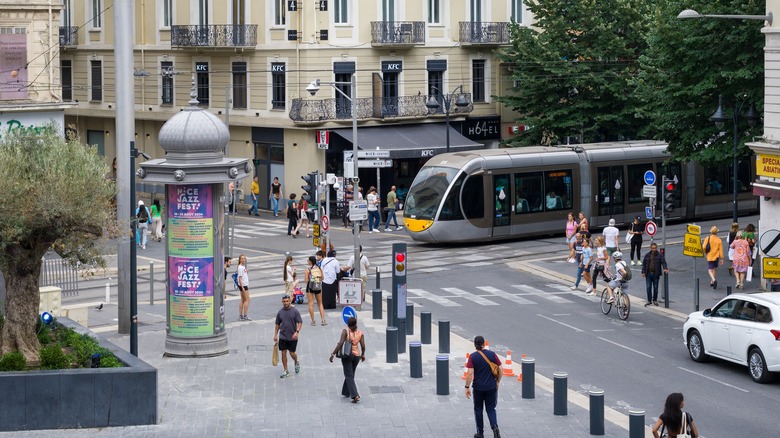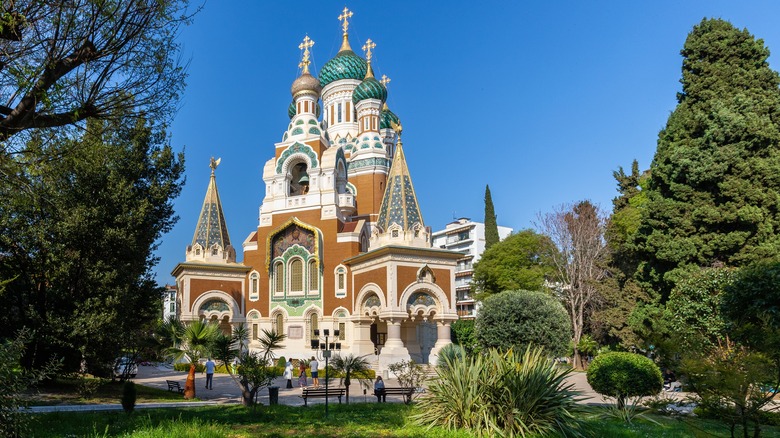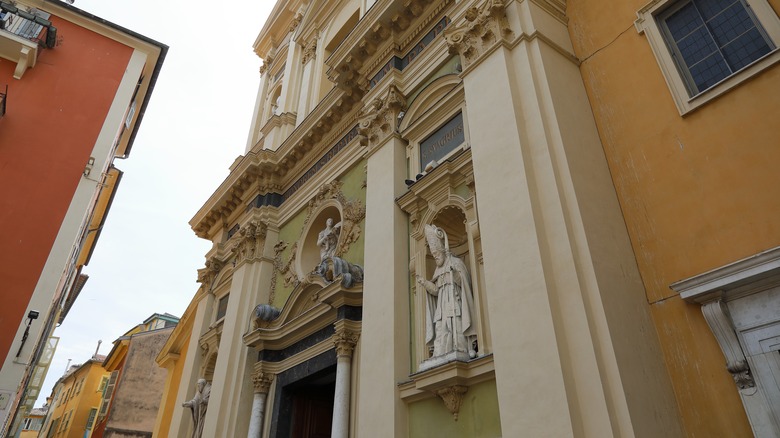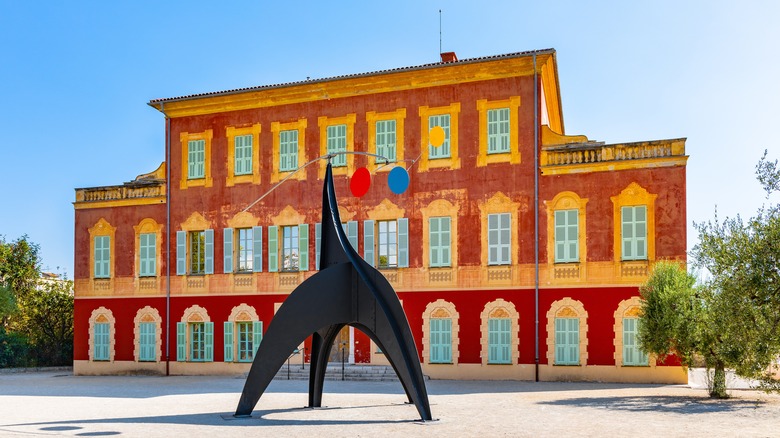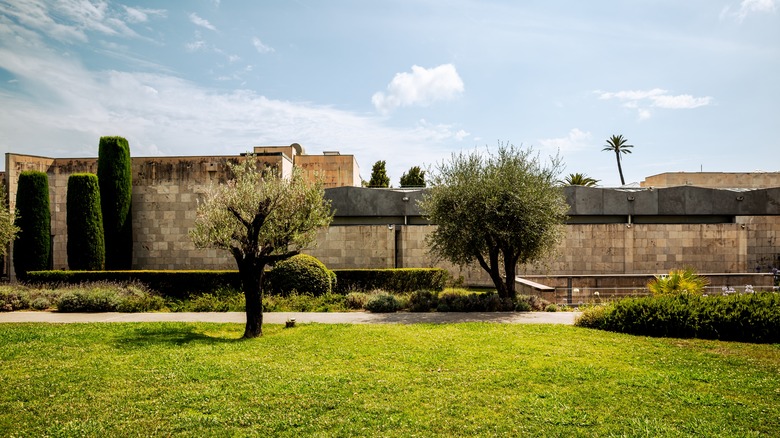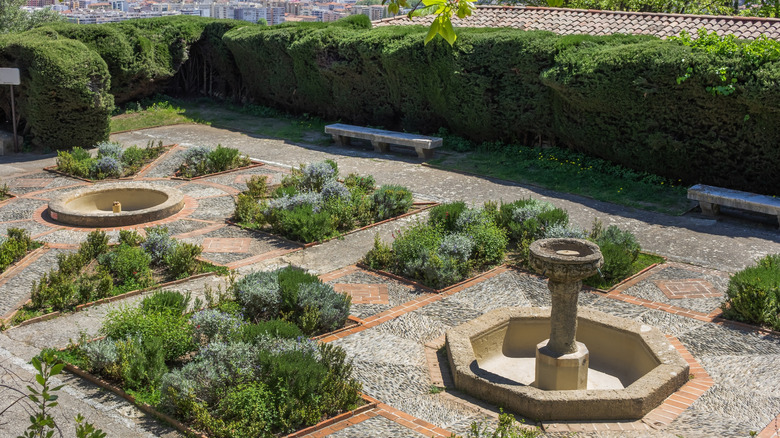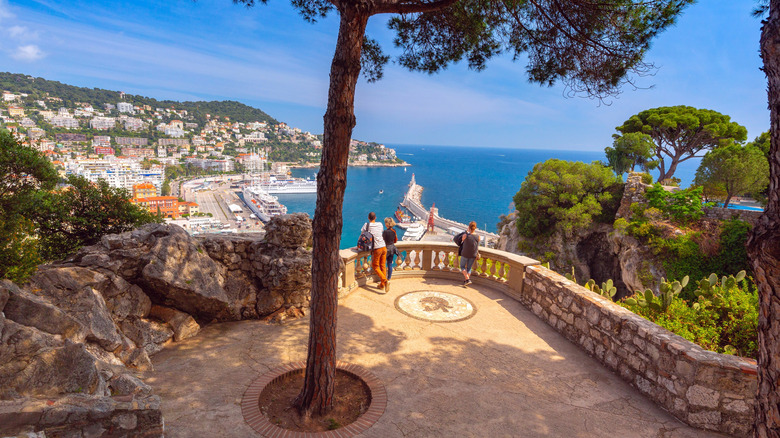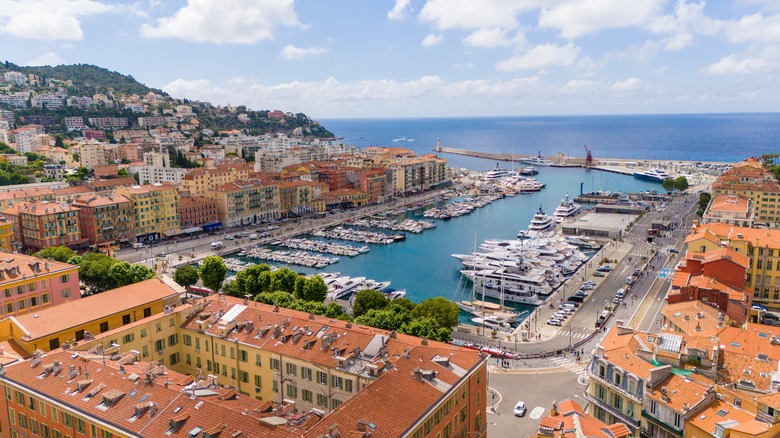Nice, France Offers Many Interesting Tourist Attractions To Experience
For generations, the French Riviera has been a go-to destination for those looking to escape to an ethereal destination with year-round pleasant weather, views so beautiful they look like a postcard even from the breathtaking airport, and a past immersed in art, architecture, and history. At the center of it all has long been Nice. It's been the chosen destination for famed artists like Henri Matisse and common folk alike, and today, it continues to be steeped in beauty and endless sights to see and things to do. It's even one of the most romantic and budget-friendly cities in the world.
So, we at PlanetWare rounded up the best tourist attractions in the city, ranging from a food and flower market with different items depending on the day of the week and the time of year to a seaside promenade home to some of the most luxurious hotels in the city. To choose which treasured spots made our list, we evaluated those that have the most and best reviews on Tripadvisor, which are the most notable in terms of history or uniqueness, and which are the most likely to satisfy people of all interests. To learn more about how we assembled this list, visit the last slide of this article.
Avenue Jean Médecin
As the epicenter of shopping in Nice, Avenue Jean Médecin is so renowned that many locals call it simply "The Avenue." It's home to stores like Galeries Lafayette, Zara, Sephora, and Monoprix. For the more high-end stores, head south, and for the trendier stores, head north.
Even if you don't want to shop, there's plenty to see on Avenue Jean Médecin, as well as restaurants and bars to unwind at. On the street is neo-Gothic church Notre-Dame de l'Assomption, which dates back to 1864 and is known for its stained glass windows as well as inspiration from the Paris Cathedral. Also, there is a blue light art installation, "L'amorce du bleu" ("Beginning of Blue"). The art piece by Yann Kersalé was inspired by the Mediterranean Sea. Artists of a different kind — like actress Barbra Streisand and singer and actor Dean Martin — have also been inspired by the bustling street. It's also where French banks such as Crédit Lyonnais and BNP Paribas are based.
The street was first built in 1864 as Avenue du Prince-Impérial, named after then-French Emperor Louis Napoleon. After several name changes, it got its current name after the former mayor of the city, who ran Nice from 1928 to 1943 and again from 1947 to 1965.
Cathédrale Saint-Nicolas de Nice
Built in honor of Russian tzar Alexander II's son, Grand Duke Nicolas Alexandrovitch, who died of meningitis while in Nice in 1865, the Cathédrale Saint-Nicolas de Nice is one of the most magnificent Russian Orthodox cathedrals in the world. A marble bust of Nicolas is outside the cathedral, which is in the Thiers district of Nice.
After the Belle Époque-style building opened in 1912, it served many Russians who called Nice home. It was a welcome addition to the Russian Orthodox community, as they had outgrown their previous local cathedral, which had been built in 1859. Today, it's still a regular place of worship. It's adorned with carved woodwork, murals, stained glass windows, gold and green tower bulbs, and icons, and was designed by Academy of Saint Petersburg architectural professor Mikhail Preobrazhensky and inspired by churches in Moscow. It's been considered a historical monument of France since 1987 and is a busy, popular spot to see in the city. If you want to avoid crowds when visiting French attractions like this one, follow Rick Steves' tips.
Vieille Ville
If you're planning to spend any length of time in Nice, you simply can't miss Vieille Ville, otherwise known as Old Town Nice. This historic neighborhood, located in the center of the city, is home to many of Nice's most iconic attractions mentioned in this story, including the Cours Saleya Market, Place Massena, Cathédrale Sainte-Réparate, and more. It's always busy with tourists and locals. The colorful square filled with narrow streets also has many shops, art galleries, restaurants, and enough charm to give you a taste of what Nice is really like in a two- or three-hour visit. That's even evident from the neighborhood's street signs, which are written in both French and Niçard, the local dialect.
However, Old Town Nice, which is between the Mediterranean Sea and Castle Hill, wasn't always so enchanting. When many residents of Castle Hill were forced to move to Old Town Nice as the Dukes of Savoy fortified Castle Hill for protection, Old Town Nice became overcrowded. That changed in the 19th century, when Nice was annexed by France. Since the 1980s, Vieille Ville has only grown in popularity with tourists as buildings and streets were revamped. Vieille Nice has plenty more to see, including Palais Caïs de Pierlas, which is where Henri Matisse once lived, as well as the Musée de la Photographie Charles Nègre, which showcases what Nice was like over the past century and a half through photos.
Cathédrale Sainte-Réparate
Vieille Ville is the quintessential neighborhood of the city, filled with charming shops and restaurants. One of its busiest parts is Place Rossetti. But overlooking the bustling square with thousands of daily visitors is the peaceful Cathédrale Sainte-Réparate, a Baroque-style cathedral inspired by St. Peter's Basilica in Rome. The cathedral is the largest in the neighborhood, although small compared to many other European churches.
Named for Saint Reparata, who is both the patron saint of Nice as well as Florence, Italy, the cathedral was consecrated in 1699. It was built over 50 years by Jean-André Guibert after being commissioned by Bishop Didier Palletis. It's now the seat of the Diocese of Nice and has also been a Historical Monument since 1906. Inside the cathedral are 10 chapels, three organs, tons of artwork, an altar with relics of Saint Reparata, and a painting of her. The relics have been the property of the city since 1060, following the saint's martyrdom in the third century.
La Promenade des Anglais
Nice is known for its seaside views, and there's no better place to soak them in than the 4.34-mile La Promenade des Anglais, which is referred to by locals simply as "Prom" and translates to "Walkway of the English." Stretching along the Baie des Anges from Parc Phoenix to Castle Hill, it's an iconic spot for both locals and visitors alike, whether they're traveling on foot, roller skates, or bike, as the promenade includes a bike path. It dates back to 1824 and was built because English tourists wanted a path to allow for easy enjoyment of the sea.
As Nice became a popular resort town with more and more tourists, the promenade grew in size and added notable landmarks. Today, those include the Art Deco-style Le Palais de la Méditerranée hotel that was a casino and theater when it was built during the 1920s; the pink Belle Epoque-style Le Negresco hotel (one of the promenade's priciest hotels) that has been the choice of celebrities like Salvador Dalí and Michael Jackson since the early 1900s; and the Villa Masséna museum which presents the life of Nice elites during the late 1800s. Other hotels along the promenade have English names, like the Westminster, that nod back to the promenade's English past. The promenade even hosts part of the annual Nice Carnival.
Cours Saleya Market
No matter what day — or time of year — you visit the Cours Saleya Market in the center of Vieille Ville, there's always something different to see here. That's because this market, which runs parallel to the Promenade des Anglais, has different items for sale depending on the day. Flowers and produce are sold Tuesdays through Saturdays; antiques and flea market items are sold on Mondays; and crafts are sold on June through September evenings. It dates back centuries, when it began as a salt — which is called "cours" in French — and seafood market. Mayor François Malausséna founded what is now the Cours Saleya Market in 1861.
Although salt is the namesake of the market, its actual staple is flowers, including orchids, ferns, cacti, sunflowers, lilies, and roses. The flowers are sold alongside produce and other foods, including cheese, nuts, olive oil, honey, pastries, olives, and spices. While here, make sure you try Nice specialties like socca, which is a chickpea pancake. During the antique and flea market, people can shop for items such as books, china, and linens, and during the craft market, they can peruse jewelry, pottery, and paintings while listening to live music. Some vendors only accept cash, so don't plan to solely rely on your credit card for purchases.
Musée Matisse
French painter and sculptor Henri Matisse was world-renowned, but there was one place where he found the most inspiration — Nice. He lived and worked in the city's Vieille Ville for nearly four decades, and he's also buried in the city. So, it's only fitting that one of the biggest collections of his works on earth also calls Nice home at the three-floor Matisse Museum, which also displays some of his personal everyday items. At the museum inside the Villa des Arènes, art lovers can see Matisse's paintings, drawings, prints, photographs, sculptures, and book illustrations, as well as a model of the Chapel of the Rosary, which Matisse designed the interior of.
Many of the museum's works were sourced right from Matisse's studio, while others were donated by Matisse's wife and children. A few of the standout pieces at the museum that you shouldn't miss include "Tempête à Nice," painted during a rainy hotel stay; "Lectrice à la table jaune," a painting of a woman reading; and "La Vague," a cut-out painting of a wave. The museum also has limited-time exhibits, so there's always something new to see here.
Musée National Marc Chagall
Henri Matisse isn't the only artist you can learn about in Nice. The city is also home to the Musée National Marc Chagall, which houses one of the largest collections in the world of Chagall's works. The museum is recognized as a place of "Remarkable Contemporary Architecture." A French artist and Russian immigrant, Chagall's work included paintings, sculptures, and stained glass, more than 250 of which are displayed in the museum located near Musée Matisse.
The works here include Chagall's 17 paintings and preparatory sketches illustrating scenes from the Bible, which were the foundation of the museum when it was established on July 7, 1973, which was also the anniversary of Chagall's birthday. The museum also showcases a 30-minute film about Chagall's life, ranging from his birth in Russia to his work alongside Pablo Picasso in Paris. Outside the museum is an African lily garden and pond that was inspired by the Garden of Eden.
Monastère Notre-Dame-de-Cimiez
Near both Musée National Marc Chagall and Musée Matisse is the Monastère Notre-Dame-de-Cimiez, a Franciscan monastery and historical monument in the Cimiez area that dates back to medieval times. It became a Franciscan monastery in the 16th century, when the Benedictine monks relinquished it to the Franciscans.
Within the monastery are sights for history buffs, art fans, and more. Paintings of the Pieta, Deposition, and Crucifixion by local artist Louis Bréa and frescoes by Hercule Trachel adorn the monastery's Notre Dame de l'Assomption church. Brea also carved the church's wood altarpiece. Other art pieces are also on display periodically as the site hosts art exhibitions. Henri Matisse is even buried in the monastery's cemetery. To learn more about the monastery's past that began in the eighth century, check out the onsite museum focused on the Franciscans' Nice history which includes more than 300 historic documents. Also here is a model of the types of cells that the monastery's monks used to live in.
One of the most colorful parts of the destination is the Jardin du Monastère de Cimiez, an Italian-style vegetable garden and orchard formerly tended to by monks. The oldest garden in the city, the nearly 103,000-square-foot garden is home to 100-year-old olive trees as well as citrus, orange, lemon, cypress, and mandarin trees surrounded by pergolas engulfed in climbing roses. Foliage is cared for without chemicals or pesticides. Visitors can also head to the garden's terrace for stunning views.
Parc de la Colline du Château
More than 300 years ago, a castle overlooking Nice that was first mentioned during the 11th century was destroyed at the command of Louis XIV, leaving behind remnants of castle walls, one which still has a cannonball dent. A cannon can also still loudly be heard in the area every day at noon, a nod to history when Sir Thomas Coventry-More supposedly fired his cannon to tell his wife to return for lunch.
Today, visitors can explore those ruins as well as views of the Baie des Anges in a city park now called Castle Hill Park, which translates to Parc de la Colline du Château in French. The park was established in 1822. To reach the top of the more-than-300-foot-tall hill, people can either climb a staircase or hop on an elevator that's where the castle's well formerly was. A hike to the top is the antidote after a night out, since Nice is one of the best European cities to visit if you enjoy nightlife.
The park includes the Bellanda Tower, a remake of one of the castle's bastions that's now a maritime museum, which is where French composer Hector Berlioz wrote the musical introduction to "King Lear." The park is also home to two cemeteries, including a Catholic cemetery where the creator of Mercedes is buried. Plus, it has a waterfall built in the late 19th centurywith a grotto, a playground for kids, stands to buy snacks, and telescopes.
Place Masséna
All of the most iconic spots in the city — including the Promenade des Anglais, Old Town, Castle Hill, and Avenue Jean Médécin — meet at Place Masséna, which is the main square of Nice. Its name pays homage to former Nice resident Marshal André Masséna, who fought in the Battle of Sardinia. The neoclassical-style checkerboard-paved square between Vieille Ville Nice and the Mediterranean Sea is at the center of the city and is also where Nice's biggest annual events take place. Those include the Nice Jazz Festival; the Christmas market that includes vendors, rides, and an ice skating rink; and the Nice Carnival that features a parade and the beloved Battle of the Flowers.
But even on an average day, there's so much to see in Place Masséna, which is over the Paillon River. One of its most famous aspects is the Fountain of the Sun, made by French sculptor Alfred Janniot in 1956. At the center of the fountain is a marble statue of Apollo, encircled by five bronze sculptures representing Greco-Roman divinities. It's surrounded by the Italian Riviera-style red buildings that are iconic of Vielle Ville. Visitors also love to check out the seven high-up statues called "Conversation à Nice" crafted by artist Jaume Plensa. The colorful statues, symbolizing each continent, are illuminated at night. It's no surprise that the square, which has been featured in movies like Alfred Hitchcock's "The Snare," was the recipient of the Travelers' Choice 2025 award from Tripadvisor.
Methodology
As a chosen vacation destination for those ranging to the rich and famous and with a seaside so beautiful it doesn't even look real, it was no small task for PlanetWare to round up the best tourist spots in Nice to help you craft your itinerary for this once-in-a-lifetime site. With so much to do ranging from exploring a luxury shopping street to wandering the age-old alleyways of Old Town, it's important to make the most out of every moment in this stunning French city — especially in the winter, when Nice becomes a surprisingly budget-friendly European city as well as a European destination that's best visited in winter.
PlanetWare wanted to help our readers do just that by first determining which Nice spots have the most and best reviews on Tripadvisor, so you can sightsee knowing that tourists just like you felt their trek was worth it. Then, we considered which sites stand out from the rest, such as how Musée National Marc Chagall has one of the largest collections of Chagall's works and Monastère Notre-Dame-de-Cimiez's garden is the oldest in Nice. Finally, we decided which destinations had the most widespread appeal, whether due to their history, art, or beauty.
